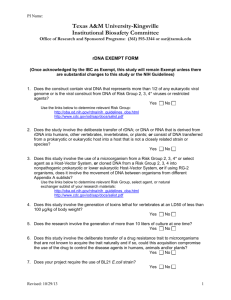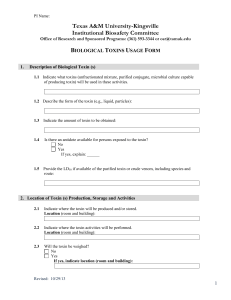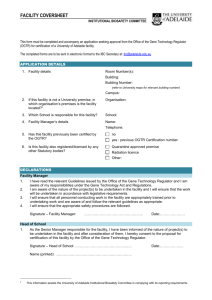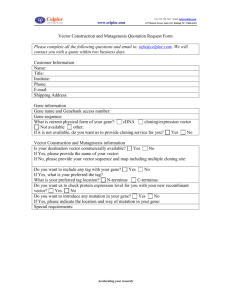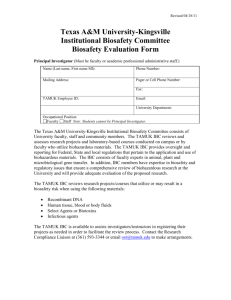Recombinant DNA and Artificial Gene Transfer Form
advertisement
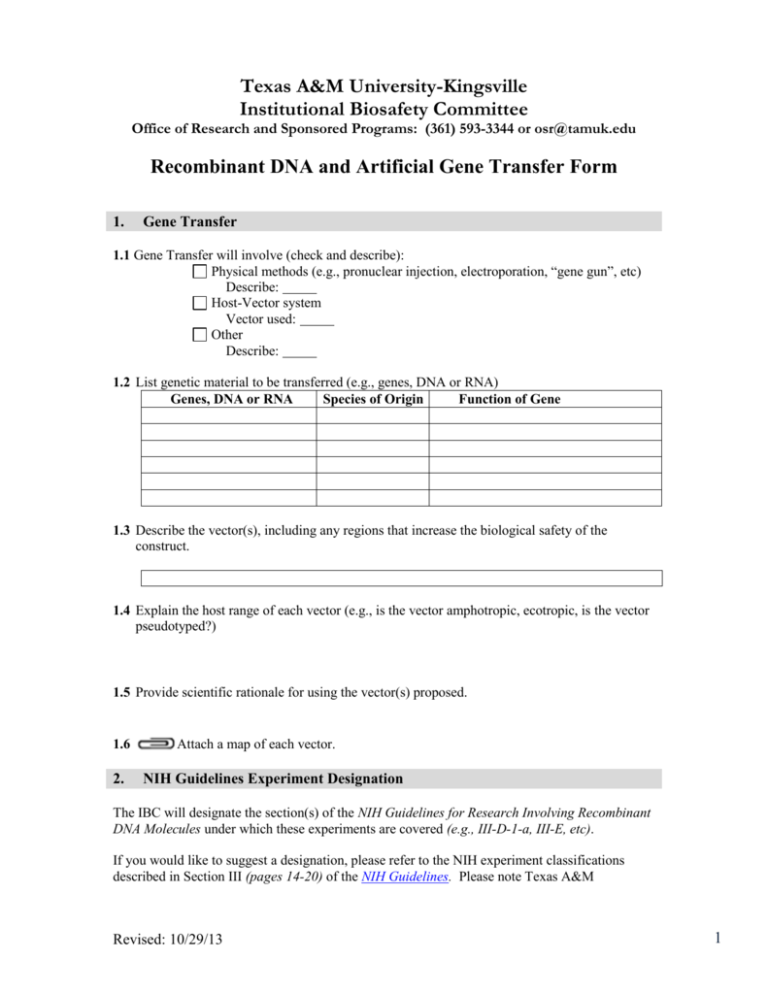
Texas A&M University-Kingsville Institutional Biosafety Committee Office of Research and Sponsored Programs: (361) 593-3344 or osr@tamuk.edu Recombinant DNA and Artificial Gene Transfer Form 1. Gene Transfer 1.1 Gene Transfer will involve (check and describe): Physical methods (e.g., pronuclear injection, electroporation, “gene gun”, etc) Describe: Host-Vector system Vector used: Other Describe: 1.2 List genetic material to be transferred (e.g., genes, DNA or RNA) Genes, DNA or RNA Species of Origin Function of Gene 1.3 Describe the vector(s), including any regions that increase the biological safety of the construct. 1.4 Explain the host range of each vector (e.g., is the vector amphotropic, ecotropic, is the vector pseudotyped?) 1.5 Provide scientific rationale for using the vector(s) proposed. 1.6 2. Attach a map of each vector. NIH Guidelines Experiment Designation The IBC will designate the section(s) of the NIH Guidelines for Research Involving Recombinant DNA Molecules under which these experiments are covered (e.g., III-D-1-a, III-E, etc). If you would like to suggest a designation, please refer to the NIH experiment classifications described in Section III (pages 14-20) of the NIH Guidelines. Please note Texas A&M Revised: 10/29/13 1 University-Kingsville policy requires that all rDNA and artificial gene transfer activities are approved by the IBC prior to initiation. Section(s): IIIThe TAMUK IBC has developed a summary of the experiments covered by the NIH Guidelines. See Appendix A located on the ORSP website at http://www.tamuk.edu/osr/forms.html . 3. Biosafety Levels 3.1 Indicate the biosafety level in the laboratory where activities will be performed. BSL1 BSL2 Location (physical location): 3.2 If animals are used, indicate the biosafety level in which they will be housed. No animals ABSL1 ABSL2 Location of animal housing (physical location): 4. Use of a Biosafety Cabinet Will work be conducted in a biosafety cabinet for these activities? No Yes If yes, what is the date of certification? 5. DNA Clones Do the DNA clones contain genes for the biosynthesis of toxic molecules lethal for vertebrates? No Yes If yes, provide documentation in the Biological Toxins Usage Form. 6. Volume of Culture Do individual activities involve more than 10 liters of culture? No Yes If yes, provide location (room and building): 7. Environmental Release Do activities involve the release of an organism containing rDNA into the environment? No Yes If yes, approval of the release must be requested from the state or federal regulatory agency. Agency: Date filed: Revised: 10/29/13 2 Attach a copy of the permit. IBC approval cannot be granted until permit is received. 8. Laboratory Procedures 8.1 Experimental activities Provide a summary of the laboratory activities that will be conducted. 8.2 Standard Operating Procedures Attach detailed Standard Operating Procedures for the experimental activities described above. 8.3 Potential Hazards and Safety Procedures Identify potential exposure hazards during sample preparation and experimental manipulations. Examples: aerosol generation when transferring, mixing and/or centrifuging, use of sharps, excretion by animals, culturing, etc. Describe the safety procedures and safety equipment used to minimize risk and prevent release of infectious agents for each potential exposure hazard, e.g. lab coats, gloves, face shield, biological safety cabinet, secondary containment for liquids, spill mats, secondary containment for centrifuge samples, etc. Potential Hazards Safety Procedures 8.4 Waste disposal Attach the Waste Disposal Plan (available on OSR website: http://www.tamuk.edu/osr/forms.html ). Call the Environmental Health and Safety Office for information about waste disposal: (361) 593-2646 or (361) 593-4131 8.5 Decontamination and Spill Clean-up Attach the Decontamination Plan (available on OSR website: http://www.tamuk.edu/osr/forms.html ), including the sections entitled “Lab Specific Requirements”. The plan must be customized for your laboratory. You have reached the end of this form. Please make sure that you have responded to every question on this application (even if your response is “not applicable”) . Save an electronic copy of this completed form and submit to osr@tamuk.edu. You will receive an electronic message from the Research Compliance Liaison within 2-3 days acknowledging receipt of your submission. Submit to: Research Compliance Liaison Revised: 10/29/13 3 Email as PDF to: OSR@tamuk.edu Mail Code: MSC 201 Fax: 361-593-3409 Revised: 10/29/13 4
